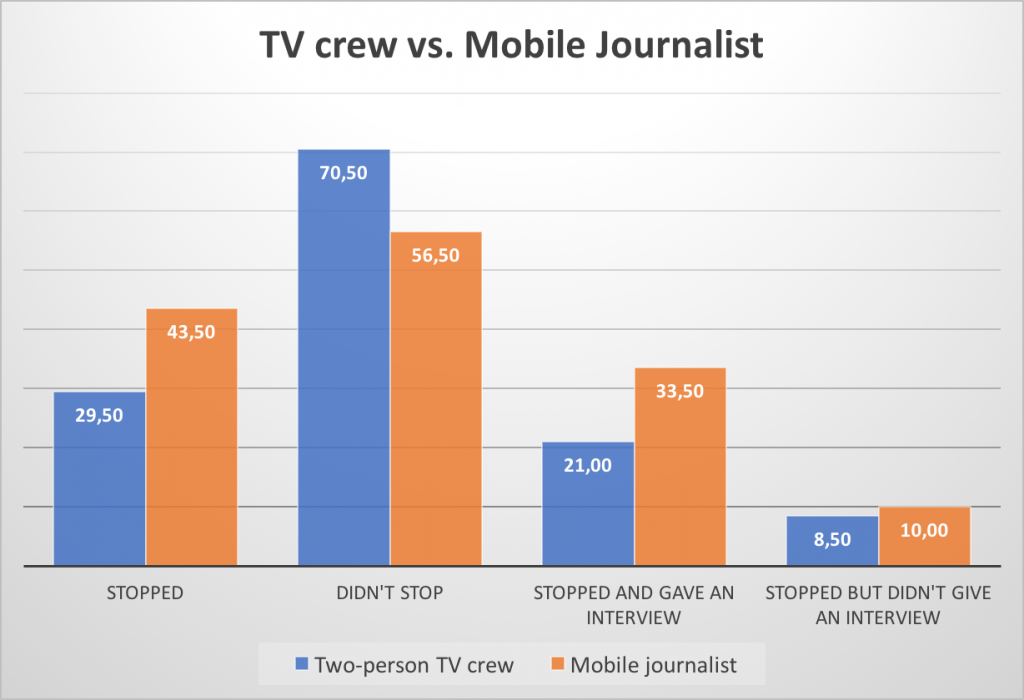New research suggests that mobile journalism can be a more efficient method of interviewing people than traditional TV journalism. In a recent field experiment, a mobile journalist was able to persuade many more people to take part in vox pop interviews than a two-person TV crew.
My recent study, Closer to the Story? Accessibility and Mobile Journalism, focused on how mobile journalism affects accessibility. The study examined whether journalists using mobile journalism techniques can get closer to the story and subject than those using more traditional journalistic tools.
As part of the research, I interviewed 11 experienced mobile journalists based in the United Kingdom, the Netherlands, Germany, Ireland, Australia, Qatar and Italy. All of the journalists agreed that mobile journalism allowed them to film stories that would have been impossible with a traditional TV camera and a multi-person crew. Most of the interviewees felt that people prefer to give interviews to a mobile journalist, either for psychological reasons or because the equipment is less intrusive.
To test the claim, I organised a field experiment in a shopping centre in Helsinki. The aim was to discover whether a mobile journalist could get more vox pop interviews than a two-person TV crew.
Altogether, 400 passers-by were approached in Kamppi shopping centre. The mobile journalist and the TV crew each approached 200 people over two days in February 2017.
The difference between the two interviewing methods was remarkable. When the mobile journalist approached the participants, 33.50% of the passers-by stopped and gave an interview. Only 21% stopped and gave an interview to the TV crew. The margin of error was 6.93 percent.

Passers-by were more likely to engage with the mobile journalist (orange) compared to the TV crew (blue).
There are two possible reasons for the difference. Firstly, the mobile journalist worked alone, while the TV crew consisted of a reporter and a camera operator. Secondly, the former used an iPhone, a handle grip, a lavalier microphone and a small external lens for filming, while the TV crew was equipped with a big camera, a camera stand and a reporter microphone.
Watch the video to see how the approaches were made.
Age and gender matters
Some of the participants were asked which interviewing method they preferred. One 23-year-old man said mobile journalism was the better method.
“If it’s a big camera, you might feel like you’re going to give some big thing or you’re going to be asked very serious questions. This is very familiar. We’re very familiar with mobile phones. We use them every day. So, it’s fine and it’s fun,” he said while standing in the front of the mobile journalist.
Another passer-by, a 26-year-old man, said the mobile journalist seemed more friendlier because he was alone: “Hard question. I haven’t encountered either of them so often. I can’t say… Perhaps I’d choose one person. There’s less pressure,” he said.
Although there were slight differences based on age and gender – mobile journalism proved a more effective method across all age groups and among males and females.
When the TV crew approached participants, 23% of people under 40 years-old and 19.47% of older people consented to be interviewed. When the mobile journalist tried to get comments he was more successful in both age groups: 39.81% of younger participants and 26.8% of older participants stopped and gave an interview.
Women were more inclined to participate in the vox pop interviews. When the mobile journalist approached people, 38.89% of the female participants and 27.17% of the male participants gave an interview. With the TV crew 25.47% of females and 15.96% of males gave an interview.
However, when the sample is split into smaller groups, the margin of error and possibility of statistical bias increases.
Do people trust mobile journalists?
Based on the field experiment, mobile journalism seems to be very efficient way to get vox pop interviews. However, it is worth mentioning that the results could vary in different kind of interviews or in different parts of the world. According to statistics, Finnish people are particularly keen on using smartphones.
One disadvantage emerged in the field experiment and in the mobile journalists’ interviews: lack of credibility can be a real problem for mobile journalists.
In the experiment, some of the participants said, that they trusted “proper” TV crews more. The problem was also mentioned several times during interviews with professional mobile journalists for the study. Along with some technological disadvantages, credibility was one of the few downsides the experienced mobile journalists pointed out.
“Sometimes, people feel that mojo is merely amateur citizen-generated footage. I think this perception is shifting as mojo become a more prevalent news form and as print journalists learn more about video,” Ivo Burum, Australia-based TV producer, journalist and academic said.
pic credit: Maarit Toivanen
Tags: digital, Finland, interviews, Journalism, Mobile journalism, Research, Reuters Institute for the Study of Journalism, Technology













































